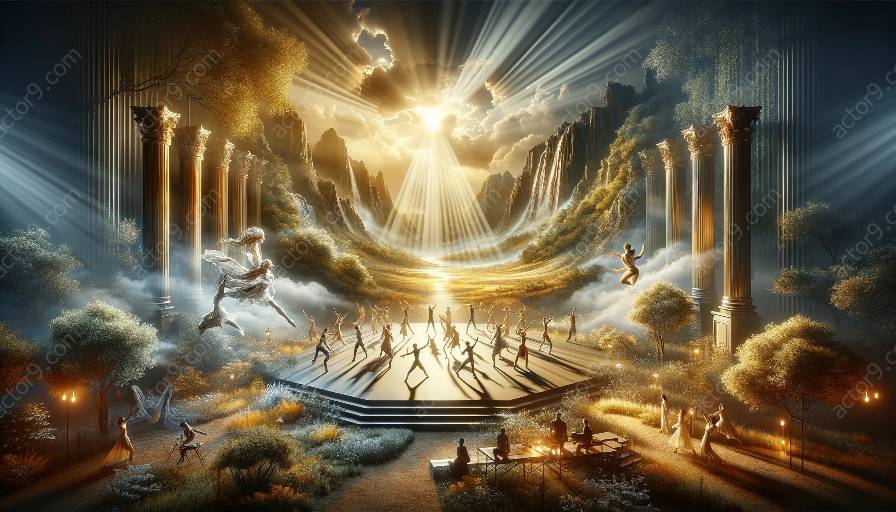Physical theatre is a dynamic art form that combines movement, gesture, and expression to convey narratives and emotions. The role of lighting in physical theatre is crucial, as it helps to enhance the dramatic and visual impact of the performance. In this article, we will delve into the collaborative processes involved in incorporating lighting into physical theatre productions, exploring its significance and techniques employed to create immersive experiences.
The Role of Lighting in Physical Theatre
Lighting plays a multifaceted role in physical theatre, serving as a powerful tool to evoke emotions, set the mood, and guide the audience's attention. It can amplify the performers' expressions, create illusions, and transform the stage into diverse environments. The interplay between light and shadow contributes to the visual composition, adding depth and dimension to the performance. In physical theatre, lighting often serves as a silent collaborator, working in tandem with the performers to enrich the storytelling and create a captivating experience for the audience.
Collaborative Processes
Integrating lighting into physical theatre productions involves a collaborative effort among various professionals, including lighting designers, directors, choreographers, and performers. The collaborative process typically unfolds in several key stages:
- Conceptualization and Vision: At the outset, the creative team gathers to conceptualize the overall vision for the production, considering the thematic elements, emotional arcs, and visual aesthetic. Lighting designers work closely with directors and choreographers to understand the narrative's nuances, character dynamics, and pivotal moments that require visual emphasis.
- Exploration and Experimentation: Once the vision is established, the collaborative team engages in exploration and experimentation. Lighting designers often conduct practical experiments with different lighting techniques, color palettes, and intensity levels to discern the most effective ways to enhance specific scenes and moods. This phase may involve workshops and rehearsals to refine lighting cues in coordination with the performers' movements and expressions.
- Integration and Coordination: As the production takes shape, the integration and coordination of lighting become paramount. Collaborative discussions and rehearsals are essential to align the lighting cues with the choreography, blocking, and overall staging. Timing, precision, and seamless transitions are critical aspects that require synchronization between the lighting design and the performers' actions.
- Refinement and Iteration: Throughout the production process, the collaborative team engages in continuous refinement and iteration. Feedback loops and open communication allow for adjustments and enhancements to the lighting design, ensuring that it aligns with the evolving dynamics of the performance and effectively conveys the intended emotions and visual impact.
Techniques and Effects
There are numerous techniques and effects employed in incorporating lighting into physical theatre productions, each serving a specific function to elevate the performance:
- Atmospheric Lighting: Utilizing variations in color, intensity, and angle to create a distinct atmosphere for different scenes, evoking moods and enhancing the overall ambiance.
- Spotlighting and Emphasis: Directing focused beams of light to accentuate specific performers, gestures, or moments, drawing the audience's attention to key elements of the performance.
- Shadow Play: Manipulating light and shadow to create captivating visual illusions, augmenting the storytelling and adding depth to the narrative.
- Dynamic Movement: Employing moving lights and dynamic lighting sequences to mirror the fluidity and energy of physical movement, amplifying the kinetic impact of the performance.
- Visual Transitions: Crafting seamless transitions and transformations through lighting effects, seamlessly altering the stage environment and guiding the audience through the narrative progression.
Significance of Lighting in Physical Theatre
Lighting holds significant importance in physical theatre by serving as a conduit for emotional expression and visual storytelling. It enhances the performers' gestures, expressions, and interactions, intensifying the audience's emotional connection to the narrative. Furthermore, lighting can transcend physical boundaries, transforming the stage into a boundless canvas for creative exploration and immersive experiences. By working collaboratively with other creative disciplines, lighting design becomes an integral component in shaping the identity and impact of physical theatre productions.
In conclusion, the collaborative processes involved in incorporating lighting into physical theatre productions are intricate and multifaceted, requiring close coordination among diverse creative professionals. The role of lighting in physical theatre extends beyond mere illumination; it shapes the very essence of the performance, orchestrating visual symphonies that enrich the audience's experience. Through exploration, experimentation, and seamless integration, lighting becomes an indispensable ally in capturing the essence of physical theatre and elevating its storytelling potential.




































